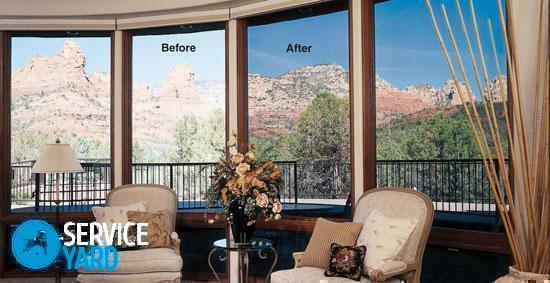
- Properties of self-adhesive film
- Which film to choose?
- We glue the film onto the windows
- What is the result?
A variety of climate technology allows today in any apartment, any house, regardless of location relative to the sides of the world, altitude and other factors, to provide a comfortable living microclimate in each room. But this option is quite expensive - both by the criterion of the original price, and the cost of installation work, further maintenance, energy consumption. Therefore, many are looking for alternative options, the benefit of such abound. One way to protect the house from heat and scorching rays is sunscreen for windows. What are its features, how effective it is and how to properly glue the sunscreen on the windows - you will learn all this from this article.
to content ↑Properties of self-adhesive film
The sun screen film for windows, despite its small thickness, has a multilayer structure. The raw materials for its production are metals - aluminum and titanium. It is thanks to these alloys that the heat-reflecting and energy-saving properties of the material are achieved.
Important! Depending on the variety, the sunscreen for windows is capable of: absorbing and reflecting 70 to 90% of ultraviolet radiation;
This result is more than satisfactory, therefore the materials of this group are very popular today.
Other properties:
- hygienic cleanliness - this must be checked by checking the manufacturer's certificates;
- fire safety - such films do not support combustion and are not amenable to ignition;
- shade - achieved a different degree of tinting, varies from one model to another.
Important! The standard width of the material is 1.52 m. This must be taken into account when calculating the quantity for a particular window structure. It is extremely undesirable to paste such a coating with pieces of paper - the web should be solid, on the whole surface of the glass.
to the contents ↑Which film to choose?
To determine the appropriate type of material, as already mentioned - it is reasonable to determine the preferred degree of tinting. Please note that the more solar direct rays get to the windows, the hotter in the rooms, the more intense the toning should be.
Important! Considerable importance in the choice of the degree of toning is not only the intensity of the ultraviolet intake, but also the structural features of the building. More precisely - which materials were used for the construction of the walls, because:
- alone themselves extinguish most of the heat or cold and regulate the microclimate in the rooms due to their natural properties;
- others - have poor insulation characteristics, so in the summer in the room during the day is impossible - the sensations as if in a steam room bath or sauna.
 Another criterion of choice is the thickness of the material. It is measured in microns and can have such parameters:
Another criterion of choice is the thickness of the material. It is measured in microns and can have such parameters:
- from 110 microns is the minimum values at which it is possible to get a satisfactory result on a solid 3 or 4;
- from 300 microns is an ideal variant if you immediately aim at a quality result, because such material not only perfectly absorbs ultraviolet, but also stands up to any mechanical loads.
The last nuance in choosing is the degree of efficiency. In this regard, distinguish materials of these types:
- average efficiency - such a sunscreen for windows is capable of passing about 40% of light and filtering up to 70% of the sun's rays;
- high efficiency - the throughput rate is up to 50% of light, but 100% of the ultraviolet flux is reflected.
Adhesive film on the windows
When the material is selected, purchased, delivered home, the question is how to glue the sunscreen on the window. We hasten to please you - no additional cash costs are foreseen, since you are fully able to perform all the work yourself.
Tools for work:
- Detergent - can be special for windows or a usual soap solution;
- Pulverizer;
- Spatula - preferably rubber or plastic, metal - highly undesirable, as it can damage the material;
- Well sharpened knife - table, stationery, building.
General rules for gluing film
There are no complicated conditions and requirements for this procedure. To glue the sunscreen on the windows, it is necessary to observe the following rules:
- Ambient temperature - in the range of 5-20 C.
- It is desirable to overcast, not too hot weather.
- Better - glue in the morning or evening, while there are no direct scorching sun rays.
Important! Of course, you can do this work at any convenient moment for you, but remember that if the sunlight with a high temperature falls on the film during the pasting, it can stretch due to high elasticity. In the end, you will get either a rupture of the material, or its deformation, which is also not very good.
Where to glue?
There are several options how to glue the sunscreen on the windows:
- on the outside of the glass unit;
- on the inside;
- in the middle.
What to give preference?- Here everything is very simple:
- The latter option is used mainly at the manufacturer of PVC windows. You can not independently disassemble it at home, and it is undesirable, and in principle - there is no need for such laborious work.
- The outer surface of the glass is an ideal option, since in this case you will get the maximum possible efficiency of the material.
- The internal surface is not a very desirable method, as this can lead to a decrease in efficiency, and when the outer part of the insulating glass is heated, the reverse result can also occur - the heater.
So, where exactly to glue the film - decided. Now on how to do it.
Glass pasting technology:
- Thoroughly clean my glass, if possible - from both sides. Divorce should not be.
- Calculate the amount of material you need and cut it out. To prevent oversight - leave gaps on each side of 0.5 cm.
- Prepare a not very concentrated solution of liquid soap or a cleaner for cleaning glass.
Important! There should not be a lot of foam, and the surface of the glass should be evenly moistened, without streaks. This allows you to easily adjust the position of the film on the window to the ideal position.
- We put the canvas on the glass.
- Correct the position.
- Armed with a spatula and smooth the material, moving from the center to the edges.
- Once all the air bubbles have come out, the surface has become perfectly smooth, leaving everything in this position and waiting for the final sticking of the film to the glass.
- When the sunscreen for windows is held tightly on the glass, do not move, take the knife and gently cut the protruding parts of the canvas along the edges.
What is the result?
If you chose a really good material, followed all the rules when installing it, you can evaluate the benefits of using a sunscreen film:
- coatings on walls, floors, as well as furniture upholstery and interior materials will not fade and fade - their color will be retained initially onthroughout the entire operation time;
- pets, plants, and you yourself will feel more comfortable, because now you will not be exposed to excessive amounts of ultraviolet;
- items in the apartment will not heat up, even on very hot summer days;
- breathing in rooms will become much easier, even if you did not install air conditioner, fan and other similar devices.
We hope, after acquaintance with the information from this article, you understand how profitable it is to glue the windows with sunscreen. In addition, it will still be useful for your health. And most importantly - the whole process does not require from you excessive investments, a lot of time and effort. Comfort in the house will be reached in the easiest way.
